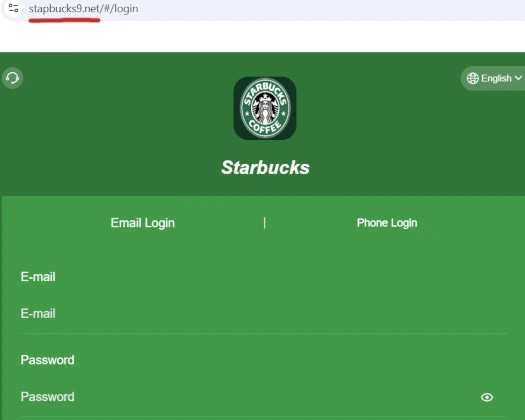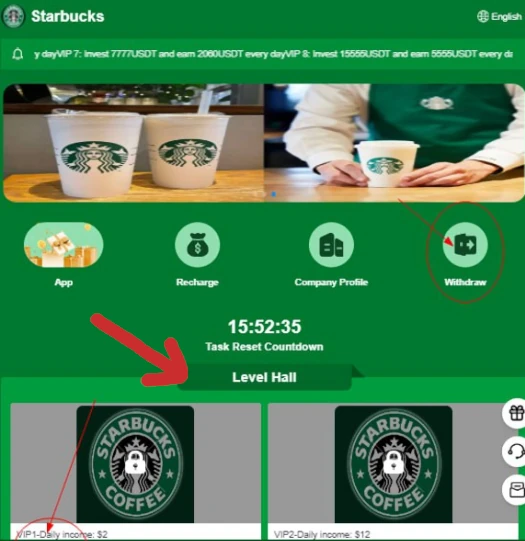Stapbucks Review: Stolen identity “click a button” Ponzi
Stapbucks fails to provide ownership or executive information on its website.
Stapbucks’ website domain (“stapbucks9.net”), was registered with bogus details on February 2nd, 2025.
Of note is Stapbucks’ website domain being registered through the Chinese registrar Alibaba (Singapore).
As always, if an MLM company is not openly upfront about who is running or owns it, think long and hard about joining and/or handing over any money.
Spabucks’ Products
Stapbucks has no retailable products or services.
Affiliates are only able to market Stapbucks affiliate membership itself.
Stapbucks’ Compensation Plan
Stapbucks affiliates invest tether (USDT). This is done on the promise of advertised returns:
- VIP1 – invest 10 USDT and receive 2 USDT a day
- VIP2 – invest 60 USDT and receive 12 USDT a day
- VIP3 – invest 220 USDT and receive 45 USDT a day
- VIP4 – invest 666 USDT and receive 140 USDT a day
- VIP5 – invest 1555 USDT and receive 360 USDT a day
- VIP6 – invest 3333 USDT and receive 860 USDT a day
- VIP7 – invest 7777 USDT and receive 2060 USDT a day
- VIP8 – invest 15,555 USDT and receive 5555 USDT a day
- VIP9 – invest 33,333 USDT and receive 13,333 USDT a day
- VIP10 – invest 55,555 USDT and receive 25,555 USDT a day
Stapbucks pays referral commissions on invested USDT down three levels of recruitment (unilevel):

- level 1 (personally recruited affiliates) – 12%
- level 2 – 2%
- level 3 – 1%
Joining Stapbucks
Stapbucks affiliate membership is free.
Full participation in the attached income opportunity requires a minimum 10 USDT investment.
Stapbucks Conclusion
Stapbucks is yet another “click a button” app Ponzi scheme.
Stapbucks misappropriates the name and branding of the Starbucks, an American multinational chain of coffeehouses.

Needless to say Stapbucks has nothing to do with Starbucks.
Stapbucks doesn’t bother coming up with a ruse. This makes it a typical “task-based” Ponzi scheme.
The assigned task in Stapbucks is “orders”. This sees Stapbucks investors log in daily to “click a button”.

Clicking the button daily qualifies Stapbucks investors to receive advertised daily returns.
Beyond that clicking a button inside Stapbucks does nothing. There is no external revenue; all Stapbucks does is recycle newly invested funds to pay earlier investors.
Stapbucks is part of a group of “click a button” app Ponzis that emerged in late 2021.
Examples of already collapsed “click a button” app Ponzis using the stolen identity ruse are FIS VIP, Trump Watches and Lindt Mall.
Since 2021 BehindMLM has documented hundreds of “click a button” app Ponzis. Most of them last a few weeks to a few months before collapsing.
“Click a button” app Ponzis disappear by disabling both their websites and app. This tends to happen without notice, leaving the majority of investors with a loss (inevitable Ponzi math).
As part of a collapse, “click a button” Ponzi scammers often initiate recovery scams. This sees the scammers demand investors pay a fee to access funds and/or re enable withdrawals.
If any payments are made withdrawals remain disabled or the scammers cease communication.
Organized crime interests from China operate scam factories behind “click a button” Ponzis from south-east Asian countries.
In September 2024, the US Department of Treasury sanctioned Cambodian politician Ly Yong Phat over ties to Chinese human trafficking scam factories.
Through various companies he owns, Phat is alleged to shelter Chinese scammers operating out of Cambodia.
Myanmar claims to have deported over 50,000 Chinese scam factory scammers since October 2023. With “click a button” app scams continuing to feature on BehindMLM though, it is clearly not enough.
In late January 2025, Chinese ministry representatives visited Thailand. The stated aim of the visit was to tackle organized Chinese crime gangs operating from Myanmar.
In early February 2025, Thailand announced it had cut power, internet access and petrol supplies to Chinese scam factories operating across its border with Myanmar.
Regardless of which country they operate from, ultimately the same group of Chinese scammers are believed to be behind the “click a button” app Ponzi plague.
Update 8th March 2025 – Stapbucks has collapsed. As at the time of this update Stapbucks’ website is no longer accessible.

